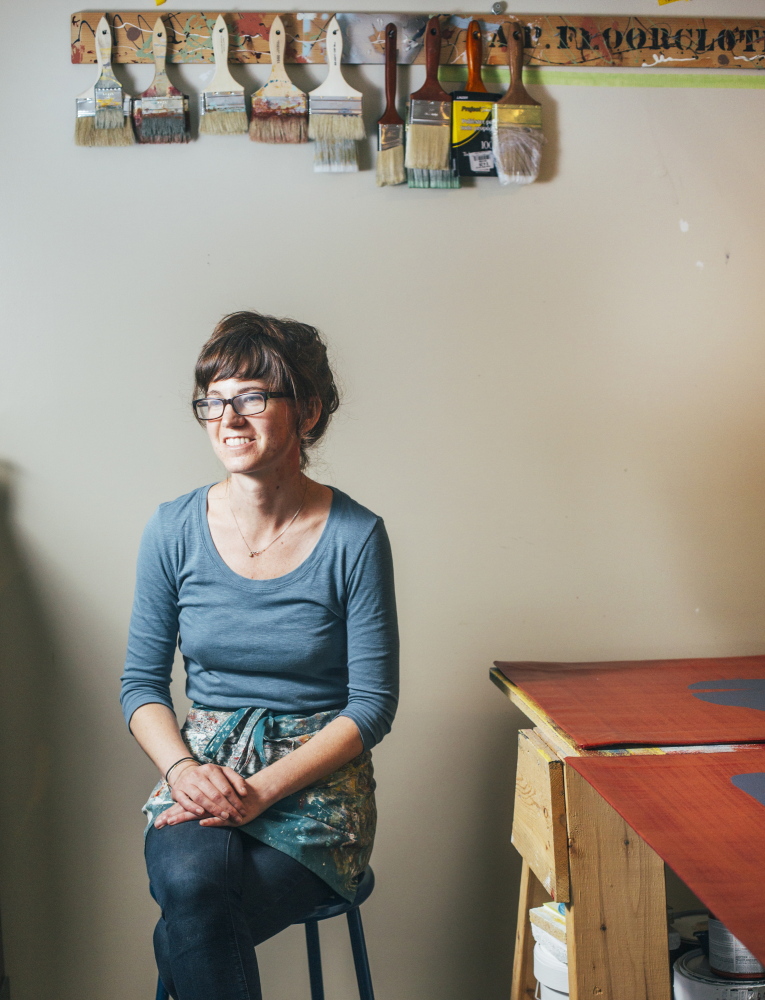After college, Addie Peet tried her hand at being a kitchen designer. But a longing to return to her family’s summer business – a wilderness camp for boys – and her fascination with a very old practical art form took her career in a different direction.
Now the Winterport designer makes floorcloths, as well as other cool canvas items. We first spotted her wares at the Common Ground Country Fair and did our best to keep our overtaxed credit cards in our wallets. But we also wondered what it is that makes these coated canvas floor coverings sustainable. We called Peet up to talk about how she makes them, the dirt under all of our carpets and why she finds the aesthetic of floorcloths so deeply satisfying.
OBSESSION: “I have always been obsessed with floor coverings of all kinds,” Peet told us. And she knew what floorcloths were, but until about eight years ago, she’d never seen one in person. She was in an old house in Harpswell maybe, or York, she can’t remember. But she does remember the rug, a reproduction of a traditional pattern from the 1800s, likely made in the 1950s.
“I finally got to put my hands on one,” she said. It was durable, washable, moveable and attractive. “It spiked my intrigue. … I was like, ‘This is so cool and it just makes so much sense.’ I couldn’t understand why they were not being produced anymore.”
Early American settlers used the painted-coated canvases in lieu of rugs. “Sometimes their flooring was just hard-packed dirt and they would take any textile they could find and place it between the floor and them as a barrier.” The early floorcloths were imported from Britain, but as time went on, the new Americans started making them.
LINO MAKES DINOS: By the early 1800s, they became a regular household item, she said. But when linoleum was invented in the Civil War era, floorcloths began to be phased out. Linoleum was also non-porous and had a marketplace advantage: “It was a lot less expensive to produce,” Peet said. “That kind of washed floorcloths to the wayside.”
A NEW PATH: Peet’s early working years had been at Flying Moose Lodge, the wilderness camp her family runs in East Orland. Her grandfather had attended the boy’s camp in the 1920s and loved it so much that he bought it in the 1940s. It has been in the family ever since. “When I thought I needed a ‘real’ job, I stopped working at the camp and you know, I really missed it. I figured it was worth it for me to find a job where I could still be at camp in the summers.” She took a job at a school so she’d have her summers free again, and not long after she’d touched that first floorcloth, she started experimenting with some of the canvas that the family uses to make the Flying Moose Lodge canoes. Maybe she could help bring them back in vogue. “I loved the idea of bringing back the lost art of floorcloths, but combining it with today’s modern materials and processes.”
GROUND FLOOR: “For the first few years, a lot of my energy was in product development.” Ultimately, the process she settled on was to start with a heavy duck canvas, shrink it, then hand-sew a hem. She layers on five coats of marine-grade acrylic pants, with five coats of a clear version of that paint. Yes, she wears a respirator. “The paint itself isn’t that bad,” she said. “They do test it on marine wildlife.”
Her goal with all that layering is “to create an extremely durable rug that will last.” She works in a basement studio, rotating projects across a field of nine tables (plans are in the works to build her a studio, with more natural light to work by). Often she enlists the help of her husband, Noah, an arborist by day. Her father helps, too, using an ancient, family-owned Chandler & Price printing press for some of the design work on the custom canvas flags she also makes.
A RUG OF HER OWN: Is her house filled with her creations? “Everyone asks that. I wish I had time to design rugs for every room in the house. My house is filled with quote unquote rejects, the rugs I wasn’t quite happy with.” She noticed that as she replaced their traditional woolen rugs with the canvas rugs, Noah’s asthma attacks seemed to lessen. It didn’t surprise her: “You can vacuum a rug and think that it is completely clean. But then you lift up the corner and see all the dirt.”
She sweeps her floorcloths and if the mood takes her, mops them. At craft shows, she always puts down floorcloths on her booth floor. That way when people admire her handiwork but say things along the lines of “I could never walk on that,” she can say, “You’re walking on it now.” Floorcloths are meant to be functional objects “that we don’t have to stress out about.”
She has two big dogs, but the floorcloths can take the abuse of their claws, she said. “I see them as benefiting a more simple lifestyle,” she said. “I think a lot of us are seeking that.”
COOLEST PROJECT? Peet incorporates some traditional floorcloth motifs into her designs, like the compass medallions that were often found in ship captain’s homes. But she has a more modern edge, which is attracting a growing customer base (she sells online and at gift shops like Hatch in Brunswick, Gifts at 136 in Damariscotta and the Island Institute’s Archipelago in Rockland).
She also works with customers on custom designs. Recently, she finished a 22-foot-long runner with a hopscotch pattern for a client in Australia. “She wanted it as an aisle runner for her wedding,” Peet said.
‘Til death do the bride and her sustainable floorcloth part.
Send questions/comments to the editors.



